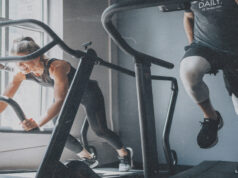As 2013 comes to a close and the season for New Year’s resolutions comes into full swing, one of the most popular goals for the New Year is to get fit and lose weight. Many of us buy gym memberships, or purchase home fitness DVDs. We’ll even blow our paychecks on a new workout wardrobe just to look the part.
While all of these can provide effective motivation to help us achieve our fitness goals, some of us can be too gung-ho, and actually sacrifice our health in the very pursuit of it. This is particularly true for inexperienced weight-lifters. If one of your goals for 2014 is to take u weight lifting, it’s important to do it the right way. Improper weight-lifting form is dangerous, and is something your body will definitely not thank you for.

Invent Your Own Exercises
Earlier this year, I noticed a young man attempting to do what I deemed as his own version of a bent-over tricep extension. Except, in his version, he kept his arm completely straight, wrenching it back as far as possible until the 25-lb. dumbbell he was holding was directly over his head. At this point, all of the weight of the dumbbell was on his shoulder joint, and none of his muscles were being engaged. I’m pretty sure he was convincing himself that the shooting pain he must’ve been feeling in his back and shoulder was just muscle burn—looked more like a future torn rotator cuff to me.
Don’t get me wrong—I’m all for creativity in the gym, except for when it comes to lifting weights. Traditional lifts are traditional for a reason: they have been shown to build muscle without overstressing the joints. If you are new to weight lifting, work with a personal trainer, or someone who knows what she’s talking about before planning a workout regimen.
Never Use a Spotter
Nearly every man I know does or has done this: before attempting a bench press or a squat, he decides to throw another couple plates on the barbell, convinced that he is strong enough to max himself out, and eager to impress any girls in the surrounding area. Then, lo and behold, the weight ends up being too much for him. The bar starts caving his chest in (or his knees begin to buckle if he’s doing power squats), and through labored gasps, he calls for help, while a couple other guys come to the rescue. So much for getting that girl’s number.
Know your limits, I cannot stress this enough. If you don’t have a sound understanding of what your body can and cannot do under physical stress, then how can you expect to push those limits and grow? Whenever you plan to reach a new max, make sure you have a reliable spotter or two to keep you safe and cheer you on.
Allow Your Back to Arch/Slouch
Lumbar strain (more commonly known as lower-back pain) is the nation’s leading non-fatal medical condition, and the Achilles heel of weight lifting. Any half-decent personal trainer can tell you the importance of keeping your back straight—whether that’s with bench press, with upright rows, with squats, heck, even with stretching. You’ll never find an exercise that is designed to make you arch or slouch your back, and if you do, you’re either doing it wrong or your “trainer” doesn’t have a clue what’s he’s talking about.
Regardless of the lift, keep your core tight. This will strengthen your abdominal muscles while relieving strain on your lumbar muscles. If at any point you begin feeling sharp pains in your lower back, STOP IMMEDIATELY and apply ice.
Cheat
I see a lot of guys at the gym practicing their bicep curls. For the sake of looking cool, too many of them will use an insanely heavy dumbbell, and their form suffers for it: they start using their entire arm and shoulder, their legs, even their hips, just to lift that dumbbell. In reality, the only muscles required for a successful bicep curl are your forearm and, get this, your bicep.
In a similar vein to allowing your back to arch or slouch, cheating on a lift is a great way to land yourself in the hospital. Cheating in weight lifting means not isolating the target muscle group, and employing a lot of unnecessary motion and effort to replicate the appearance of a successful lift. Also, jerking the weight into the desired position, rather than going for a smooth, constant motion, is just asking for trouble, and qualifies as cheating.
The year 2014 is full of promise. It means new opportunities, new experiences, and future memories in the making. Don’t limit your possibilities by being over-zealous on your weight-lifting goals—especially if you’re going it alone. Do your homework, grab a buddy, and most importantly, keep your back straight.












